The state of Virginia is home to 30 species of native snakes. Depending on the climate, there are certain species more prevalent in each location. Some of these snakes range from large to lethal, depending on the species. But are any both? In other words, is the size of a snake indicative of how venomous it is? The simple answer to this is no. Big doesn’t always mean dangerous in the animal realm. To put this into perspective, the world’s deadliest critter is the little mosquito, inflicting nearly one million deaths each year!
Certain snakes can be quite formidable if you are ignorant of their habitats and habits. And some can seem intimidating in appearance but pose no threat. So, how can you be sure which snakes are a potential threat? What are Virginia’s largest and most venomous snakes to be aware of this summer? Below, we uncover the top three largest and the top three most dangerous snakes to keep an eye out for in Virginia this summer. Let’s find out if any of them are both large and lethal!
Measuring 79.8 inches (6 feet 7 inches) in total, the harmless eastern ratsnake is the largest snake ever recorded in Virginia history! This proves that just because a snake is large does not mean it’s dangerous. Let’s look deeper at these snakes, whose lengths surpass the height of the average human being.
1. Eastern Ratsnake
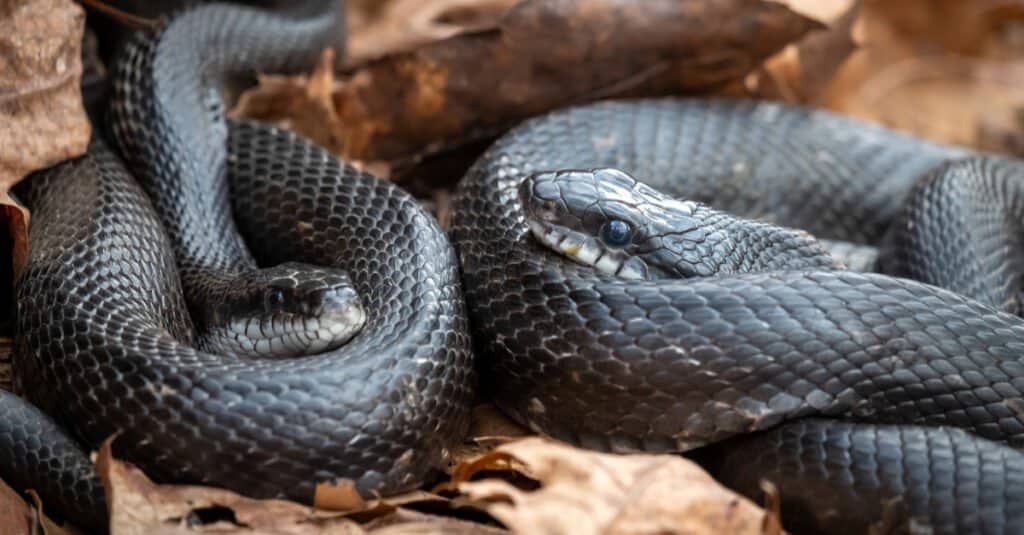
There is no threat to humans from eastern ratsnakes because they are not venomous.
©samray/Shutterstock.com
Appearance
The eastern ratsnake has a black and white checkered belly, while its upper body is shiny black with keeled scales. The skin on the face and throat is either white or cream. Juveniles have a very distinct appearance. The gray and brown spots on a pale gray background make for an eye-catching design on their backs.
Danger Level
There is no threat to humans from eastern ratsnakes because they are not venomous. They are also non-aggressive and typically avoid any human interaction. However, if the snake feels trapped, it will strike.
Habitats and Habits
Aside from the state of VA, eastern ratsnakes can be found from C.T. to S.C. and west to the middle of K.S. and O.K. in fields, forests, farmland, and suburban areas. Even though ratsnakes are nocturnal in warm locations, they are nevertheless active during the day. They can be seen lounging in the sun, out in the woods, or on the plains, looking for food.
2. Northern Pinesnake
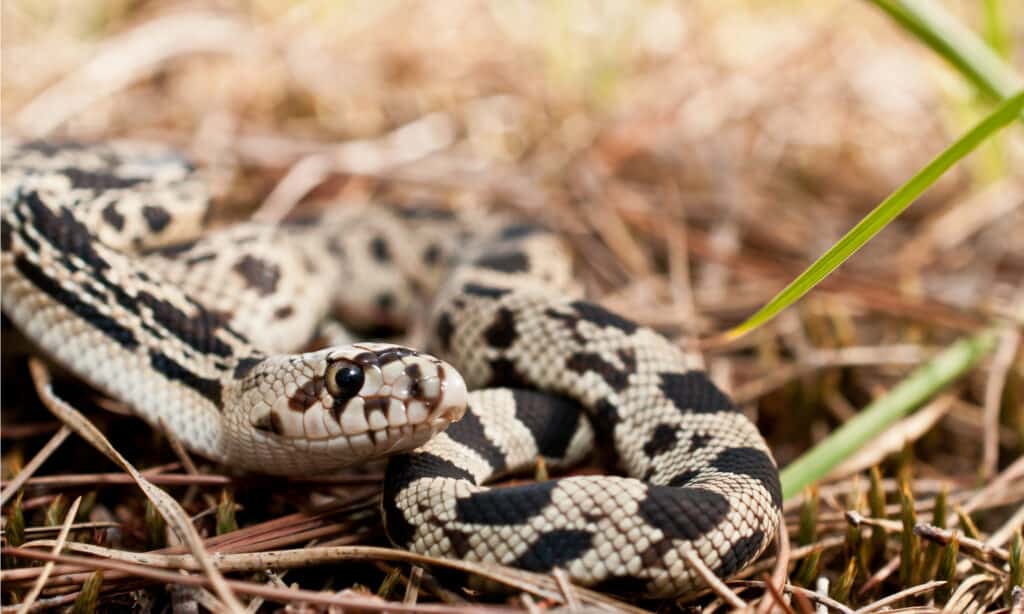
Pine snake bites can be painful even though they are not venomous.
©Jay Ondreicka/Shutterstock.com
Appearance
The northern pine snake coloring varies in the wild. Some specimens have a bright white color; however, this is rare. Northern pines have a base hue of off-white to light buff, with some yellowing. About 30–39 patches of deep brown or black occur along the dorsum’s ridge. These spots might be clustered together. Some specimens have interesting spots that shift color from black to mahogany or chestnut-red towards the midbody. The rest of the dorsum has little black dots. These color patches lack a pattern.
Danger Level
Pine snake bites can be painful even though they are not lethal. If you happen to catch a northern pine snake by surprise, it may hiss and vibrate its tail at you, but it won’t harm you.
Habitats and Habits
Since pine snakes spend most of their time underground, even in places where they are known to exist, it is rare to observe one in the wild. When they are most active in the spring and early summer, they search for rats and other small mammals to feed by going from burrow to burrow.
3. Timber Rattlesnake
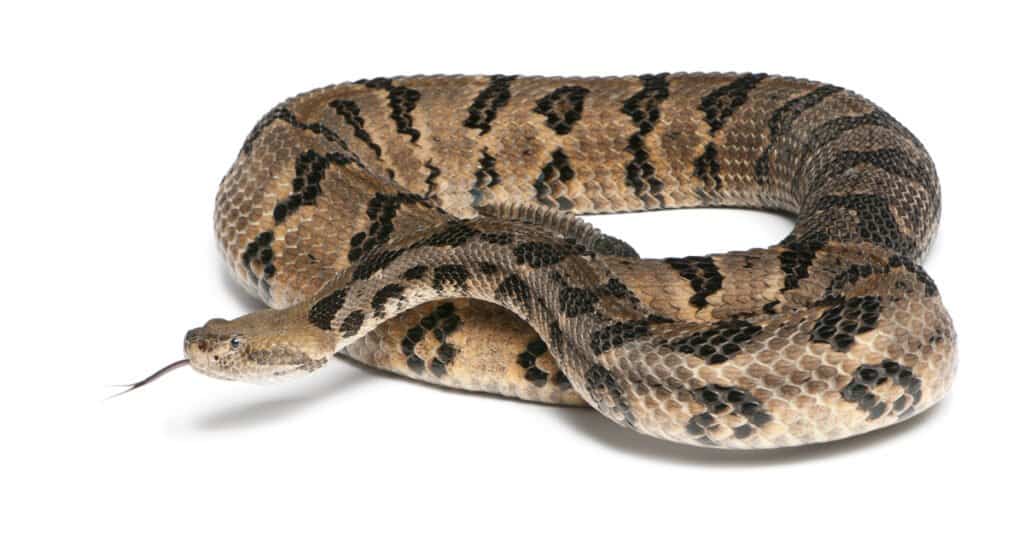
The timber
rattlesnake
tends to remain coiled or stretched out, motionless, if it encounters a predator.
©Eric Isselee/Shutterstock.com
Appearance
The coloring of the timber rattlesnake varies across their range. Their bodies are striped with light and dark lines. They can be brown, grey, or black in the north but tan or yellow in the south. Their undersides are cream-colored. The end of the body is always dark. Their scales are keeled, giving them a rough body. Their triangular head is yellow, tawny, or gray. A dark line stretches from the eye to the mouth. The coloring of these snakes will help them blend into the forest floor while waiting for prey.
Danger Level
Timber rattlers are highly venomous, and they have long fangs that they utilize to inject their prey with venom. The venom toxicity poses a serious threat to human life. Unlike other rattlesnakes in its family, the timber rattlesnake tends to remain coiled or stretched out, motionless, if it encounters a predator in its natural habitat. If you come across this large snake, do not approach it!
Habitats and Habits
This snake is found in much of the eastern U.S., but its distribution is spotty in many locations. This species inhabits a wide range of environments. They prefer rocky locations and often hibernate in crevices or small caves. Their habitats include woods, wetlands, swamps, mountains, and more. Unlike several rattlesnakes, this one avoids crowded areas. The timber rattler is diurnal during spring and dall, but switches to crepuscular (morning and evening) activity when the summer heats up.
Summary of 3 Largest Snakes in Virginia
Here’s a recap of the largest snakes in the state of Virginia:
| Snake | Average Adult Length | Virginia Record |
|---|---|---|
| Eastern Ratsnake | 42–72 inches | 79.8 inches |
| Northern Pinesnake | 48–66 inches | 66.1 inches |
| Timber Rattlesnake | 36–60 inches | 67.1 inches |
3 Most Dangerous Snakes in Virginia This Summer
This means that all three venomous snakes found in Virginia are pit vipers: they’re the copperhead, timber rattlesnake, and water moccasin. The timber rattlesnake, Virginia’s third-largest snake, appears to be the state’s most dangerous rattlesnake. It looks like we’ve got a “killer” combination going on. Let’s take a closer look at this group of fearsome reptiles.
1. Timber Rattlesnake
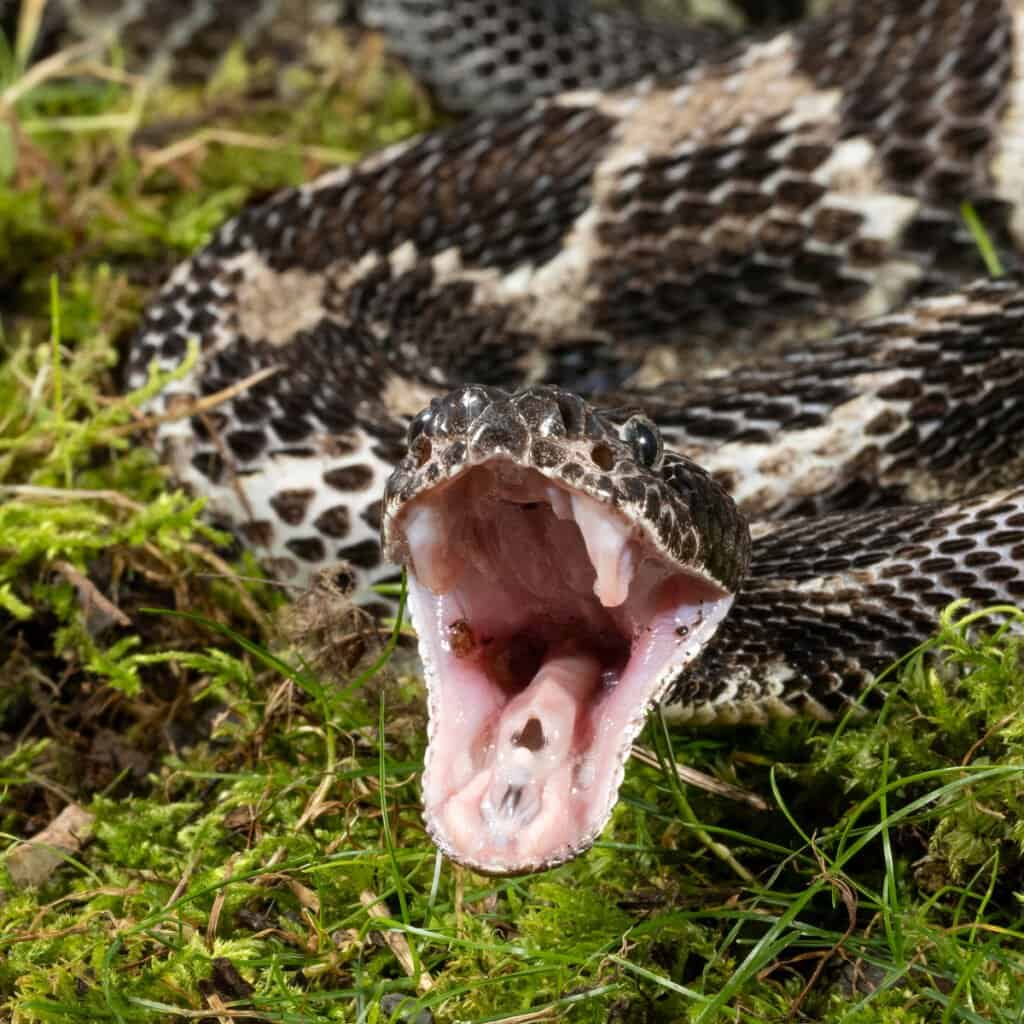
The timber rattler’s venom can kill a human with a fraction of the venom it takes for other snakes to kill.
©Joe McDonald/Shutterstock.com
Considering what we learned about this snake in the preceding section, we can safely say that it is large and dangerous. However, did you know that the timber rattler’s venom can kill a human with a fraction of the venom it takes the northern cottonmouth and eastern copperhead to kill? One-third to one-half the amount of venom, to be exact.
2. Northern Cottonmouth
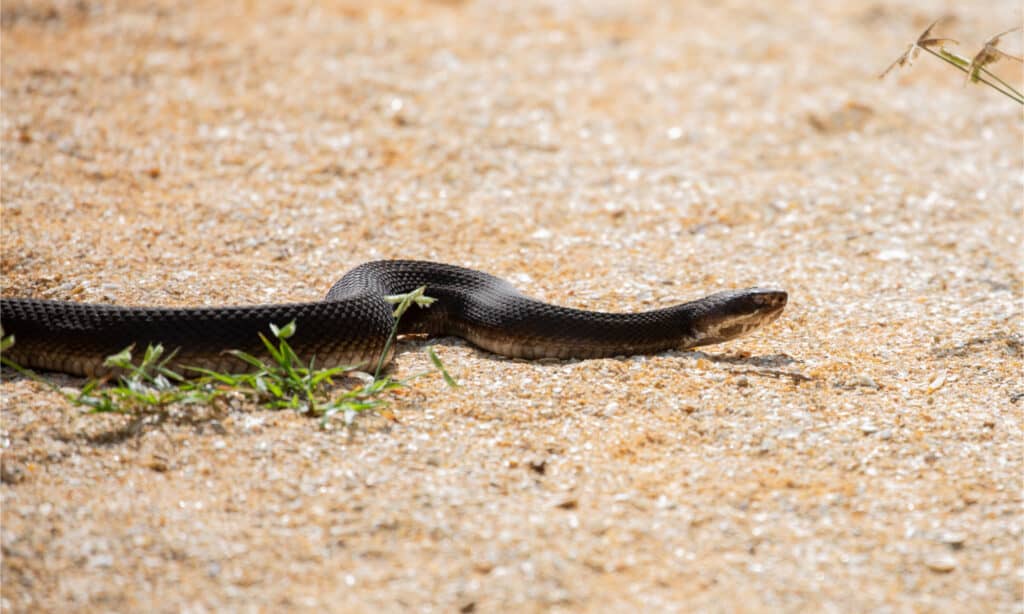
Cottonmouth venom contains hemotoxins, which inhibit blood clotting and coagulation.
©Linda Burek/Shutterstock.com
Appearance
Northern cottonmouths are usually solid brown to almost black in appearance with keeled scales. Younger snakes show significantly more patterning with alternating deep brown and light brown bands going down the body and a uniformly dark tail with a yellow tip.
Danger Level
The northern cottonmouth can kill its prey with just one bite. Cottonmouth venom contains hemotoxins, which inhibit blood clotting and coagulation by destroying blood cells. Even though death is quite improbable should a human get bitten, it can happen. Therefore, you should always seek medical help immediately if snake bites. The good news is that there isn’t much of a reputation for this species being antagonistic unless provoked.
Habitats and Habits
Northern cottonmouths are distributed in the Eastern U.S. and are most prominent in the southeast regions of Virginia. In addition to swamps and freshwater marshes, these snakes are found around ponds. In the spring and fall, they will spend time in the sun, but otherwise, they are mostly nocturnal.
3. Eastern Copperhead
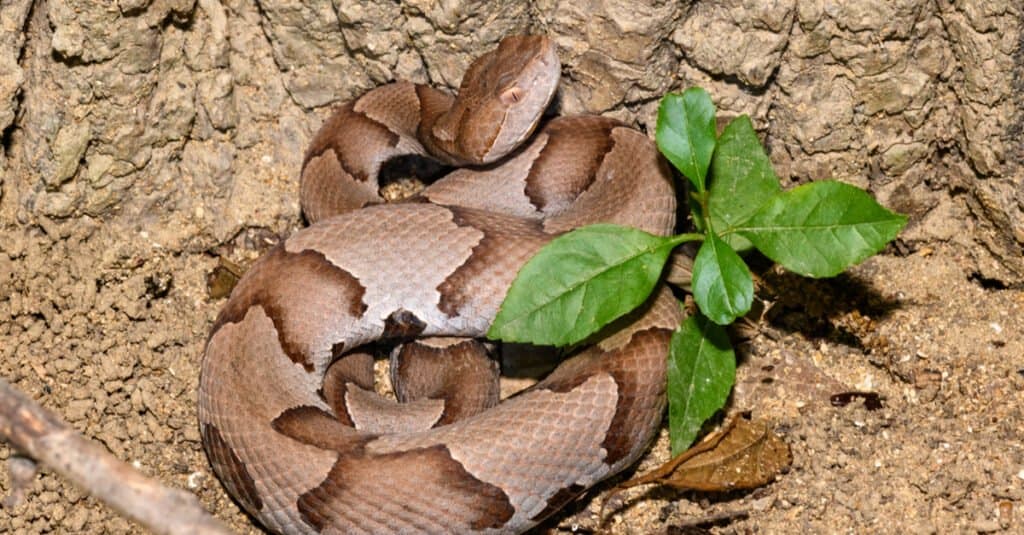
Copperhead bites are emergencies; if not treated ASAP, they can cause wounds, amputations, and rarely death.
©Jeff W. Jarrett/Shutterstock.com
Appearance
This species of eastern copperhead has a copper-tinted head, hence its name, and a reddish-brown body. It has darker, hourglass-like markings on the back, which is characteristic of the copperhead family. Its underside is tinged with a rosy color, and its eyes are elliptical.
Danger Level
Compared to the venom of many of its relatives, the copperhead’s venom isn’t as toxic. However, the copperhead is a dangerous reptile that deserves respect because it is responsible for the bulk of continent-wide venomous snake bites. Although the copperhead is typically non-aggressive, most bites happen because of mishandling or harassment of the snake species. Copperhead bites are still a medical emergency; if not treated immediately, they can cause severe wounds, amputations, or even death.
Habitats and Habits
Copperheads are native to the eastern United States and range from Alabama to West Virginia. The eastern copperhead prefers lush pine and hardwood woods with low, wet regions bordering marshes, river bottoms, and gorges. Large logs, trash, and rock piles are common shelters. This species occurs in suburban areas where development encroaches on suitable habitats. Spring and October are the most opportune times for eastern copperheads to be seen during daylight, as they become more nocturnal during the scorching summer temperatures.
Summary of 3 Most Dangerous Snakes in Virginia
Here’s a recap of the three most deadly snakes in the state of Virginia:
| Snake | Average Adult Length | Virginia Record |
|---|---|---|
| Timber Rattlesnake | 36–60 inches | 67.1 inches |
| Northern Cottonmouth | 30–48 inches | 74.1 inches |
| Eastern Copperhead | 24–36 inches | 48 inches |
In Conclusion
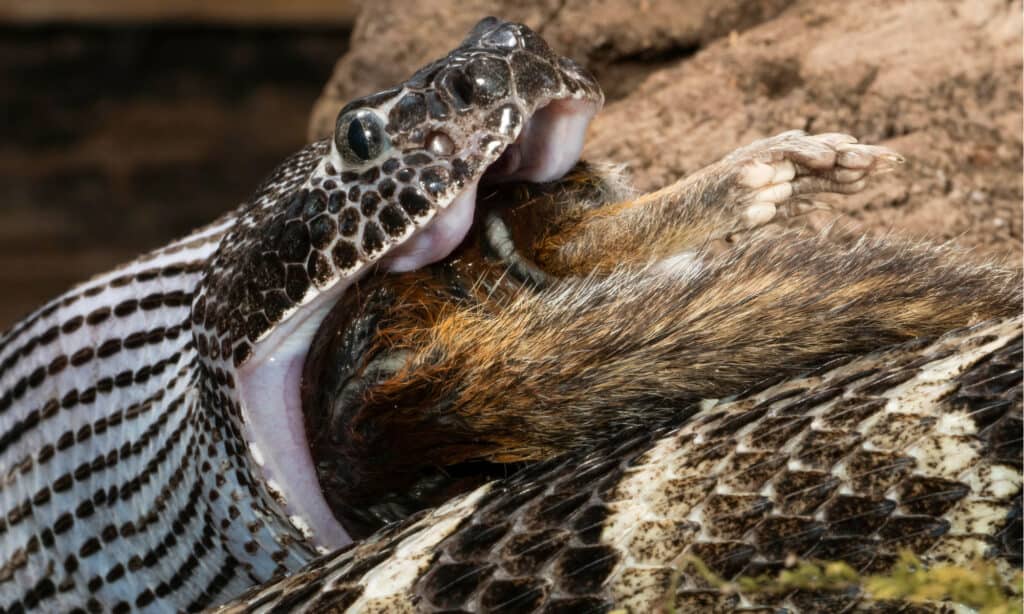
Various harmless snakes, especially water snakes, are sometimes mistaken as lethal and unjustly killed.
©Joe McDonald/Shutterstock.com
Though some of Virginia’s dangerous snakes are deadly, they rarely cause harm to humans. Certain snake bites can kill, but most snakes prefer to flee from confrontation. As a bonus, snakes help keep rodents at bay and are vital to our ecosystems. Unfortunately, human activity takes its toll on these snakes. Populations have been decimated across most of their range due to natural and human-related causes. Various harmless snakes, especially water snakes, are sometimes mistaken as lethal and unjustly killed. Learn to identify the snakes in your state and do not kill snakes unnecessarily. Fortunately, more states are enacting legislation to save their native snakes.
The photo featured at the top of this post is © Scott Delony/Shutterstock.com
Discover the "Monster" Snake 5X Bigger than an Anaconda
Every day A-Z Animals sends out some of the most incredible facts in the world from our free newsletter. Want to discover the 10 most beautiful snakes in the world, a "snake island" where you're never more than 3 feet from danger, or a "monster" snake 5X larger than an anaconda? Then sign up right now and you'll start receiving our daily newsletter absolutely free.
Thank you for reading! Have some feedback for us? Contact the AZ Animals editorial team.






